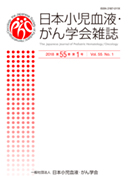Volume 58, Issue 5
Displaying 1-26 of 26 articles from this issue
- |<
- <
- 1
- >
- >|
The 62nd Annual Meeting of the Japanese Society of Pediatric Hematology / Oncology
-
2021Volume 58Issue 5 Pages 331-339
Published: 2021
Released on J-STAGE: February 08, 2022
Download PDF (2768K)
-
2021Volume 58Issue 5 Pages 340-345
Published: 2021
Released on J-STAGE: February 08, 2022
Download PDF (919K)
-
2021Volume 58Issue 5 Pages 346-349
Published: 2021
Released on J-STAGE: February 08, 2022
Download PDF (2194K) -
2021Volume 58Issue 5 Pages 350-357
Published: 2021
Released on J-STAGE: February 08, 2022
Download PDF (2314K)
-
2021Volume 58Issue 5 Pages 358-362
Published: 2021
Released on J-STAGE: February 08, 2022
Download PDF (3821K)
-
2021Volume 58Issue 5 Pages 363-368
Published: 2021
Released on J-STAGE: February 08, 2022
Download PDF (7857K) -
2021Volume 58Issue 5 Pages 369-373
Published: 2021
Released on J-STAGE: February 08, 2022
Download PDF (2983K) -
2021Volume 58Issue 5 Pages 374-377
Published: 2021
Released on J-STAGE: February 08, 2022
Download PDF (1311K)
-
2021Volume 58Issue 5 Pages 378-383
Published: 2021
Released on J-STAGE: February 08, 2022
Download PDF (2352K) -
2021Volume 58Issue 5 Pages 384-387
Published: 2021
Released on J-STAGE: February 08, 2022
Download PDF (1074K)
-
2021Volume 58Issue 5 Pages 388-394
Published: 2021
Released on J-STAGE: February 08, 2022
Download PDF (1184K)
-
2021Volume 58Issue 5 Pages 395-398
Published: 2021
Released on J-STAGE: February 08, 2022
Download PDF (1855K) -
2021Volume 58Issue 5 Pages 399-404
Published: 2021
Released on J-STAGE: February 08, 2022
Download PDF (1035K)
-
2021Volume 58Issue 5 Pages 405-409
Published: 2021
Released on J-STAGE: February 08, 2022
Download PDF (3381K)
-
2021Volume 58Issue 5 Pages 410-413
Published: 2021
Released on J-STAGE: February 08, 2022
Download PDF (2485K)
-
2021Volume 58Issue 5 Pages 414-418
Published: 2021
Released on J-STAGE: February 08, 2022
Download PDF (846K)
Original Article
-
2021Volume 58Issue 5 Pages 419-423
Published: 2021
Released on J-STAGE: February 08, 2022
Download PDF (860K) -
2021Volume 58Issue 5 Pages 424-431
Published: 2021
Released on J-STAGE: February 08, 2022
Download PDF (1057K) -
2021Volume 58Issue 5 Pages 432-436
Published: 2021
Released on J-STAGE: February 08, 2022
Download PDF (905K)
Case Report
-
2021Volume 58Issue 5 Pages 437-441
Published: 2021
Released on J-STAGE: February 08, 2022
Download PDF (3066K) -
2021Volume 58Issue 5 Pages 442-445
Published: 2021
Released on J-STAGE: February 08, 2022
Download PDF (2904K) -
2021Volume 58Issue 5 Pages 446-449
Published: 2021
Released on J-STAGE: February 08, 2022
Download PDF (1529K) -
2021Volume 58Issue 5 Pages 450-454
Published: 2021
Released on J-STAGE: February 08, 2022
Download PDF (2942K) -
2021Volume 58Issue 5 Pages 455-458
Published: 2021
Released on J-STAGE: February 08, 2022
Download PDF (1768K)
Report
-
2021Volume 58Issue 5 Pages 459-461
Published: 2021
Released on J-STAGE: February 08, 2022
Download PDF (706K)
Reviewer List
-
2021Volume 58Issue 5 Pages 462
Published: 2021
Released on J-STAGE: February 08, 2022
Download PDF (485K)
- |<
- <
- 1
- >
- >|
